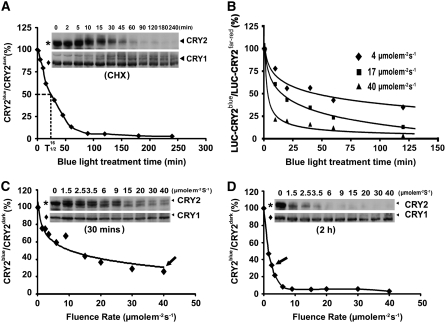Figure 3.
Kinetics of Blue Light–Dependent Degradation of Endogenous CRY2 in Wild-Type Seedlings or LUC-CRY2 in Transgenic Seedlings.
(A) Immunoblot showing endogenous CRY2 in etiolated wild-type seedlings exposed to blue light (16 μmol m−2 s−1) for the indicated time. Five-day-old etiolated seedlings were treated with cycloheximide (CHX) for 4 h before transferring to blue light for the indicated duration. Protein samples were extracted, fractioned by 10% SDS-PAGE, and blotted. The immunoblot was probed with anti-CRY2, stripped, and reprobed with anti-CRY1 antibodies. The relative level of CRY2 (including both phosphorylated upper bands and unphopsphorylated lower band) is calculated as described (see Methods) and presented as CRY2blue (level of CRY2 after blue light treatment)/CRY2dark (level of CRY2 before blue light treatment).
(B) Change in luminescence of LUC-CRY2 seedlings in response to blue light. LUC-CRY2 seedlings were grown on MS medium (∼150 seedlings per Petri dish) in far-red light for 5 d and exposed to blue light of the fluence rates and durations indicated. The luminescence of untreated and blue light–treated seedlings was measured using a CCD camera, and the relative luminescence per seedling is presented as the percentage of LUC-CRY2blue (luminescence after blue light treatment)/LUC-CRY2far-red (luminescence before blue light treatment).
(C) and (D) Immunoblot showing endogenous CRY2 in etiolated wild-type seedlings exposed to blue light with the fluence rates indicated for 30 min (C) or 2 h (D). The relative level of CRY2 is calculated as in (A). Arrows indicate the fluence rates by which ∼70% of CRY2 was degraded.

